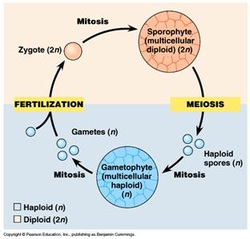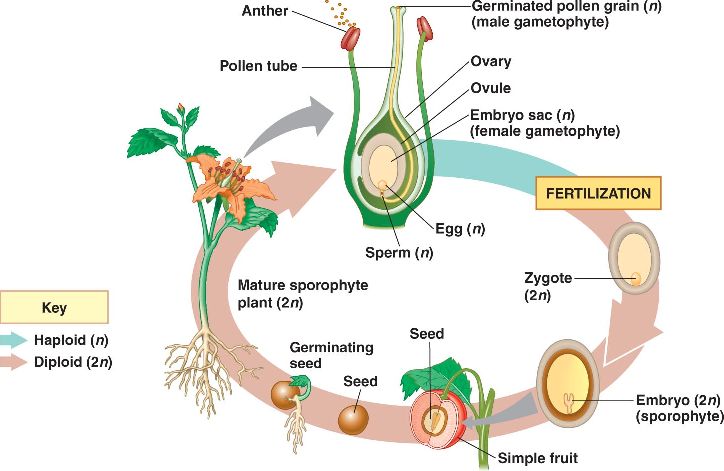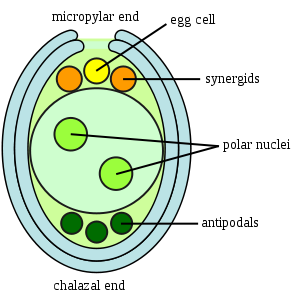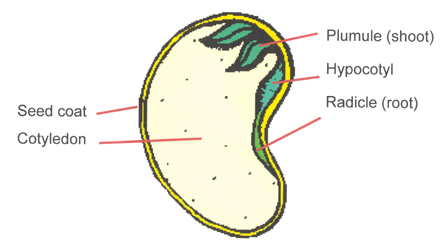38.1: flowers, double fertilization, and fruits are unique features of the angiosperm life cycle

Alternation of Generations
A process where haploid (n) and diploid (2n) generations alternating in producing each other. The sporophyte (diploid plant) produces haploid spores through the process of meiosis. The spores divide by mitosis, creating multicellular gametophytes (n): male and female haploid plants that produce either sperm or eggs.
Fertilization
Fusion of gametes which results in zygotes (2n). Zygotes divide by mitosis into new sporophytes.
Angiosperms are primarily in the sporophyte generation. The life cycle of angiosperm is remembered by the "three Fs": flowers, (double) fertilization and fruits.
A process where haploid (n) and diploid (2n) generations alternating in producing each other. The sporophyte (diploid plant) produces haploid spores through the process of meiosis. The spores divide by mitosis, creating multicellular gametophytes (n): male and female haploid plants that produce either sperm or eggs.
Fertilization
Fusion of gametes which results in zygotes (2n). Zygotes divide by mitosis into new sporophytes.
Angiosperms are primarily in the sporophyte generation. The life cycle of angiosperm is remembered by the "three Fs": flowers, (double) fertilization and fruits.
FLOWER STRUCTURE AND FUNCTION
DEVELOPMENT OF MALE GAMETOPHYTES IN POLLEN GRAINS
The anther contains four pollen sacs (microsporangia) which intern contain microsporocytes. The microsporocyte under goes the following steps:
DEVELOPMENT OF FEMALE GAMETOPHYTES (EMBRYO SACS)
The entire developmental process of the embryo sacs occurs within the carpel's ovary, in megasporangium, a tissue within the ovules. The megasporangium is surrounded by two integuments (layers of protective tissue) everywhere but a gap called the micropyle.
The Process:
- Flowers are the reproductive shoots of angiosperm sporophytes
- They stop growing once flower and fruit are formed
- Sepals: Sterile. Encloses and protects the bud. Usually green and leaf like.
- Petals: Sterile. Advertises the flower to pollinators
- Stamen: Reproductive organ. Consists of a stalk (the filament) and the anther, which produces pollen.
- Carpel: Reproductive organ. Has an ovary (which contains one or more ovules) at it's base and a neck called the style, topped with the stigma – landing platform for pollen.
DEVELOPMENT OF MALE GAMETOPHYTES IN POLLEN GRAINS
The anther contains four pollen sacs (microsporangia) which intern contain microsporocytes. The microsporocyte under goes the following steps:
- Forms four haploid microspores through meiosis.
- Each microspore goes through mitosis and gives rise to a haploid male gametophyte that consists of a generative cell and a tube cell. These cells and the spore wall together form a pollen grain.
- When the male gametophyte matures the generative cell passes into the tube cell to complete the spore wall.
- Microsporangium breaks and releases pollen.
- Pollen attaches to a stigma.
- Here, the tube cell produces a pollen tube, which delivers sperm to the female gametophyte.
- While the tube cell is growing, the generative cell divides into two sperm cells. These cells are released through the tube cell when it reaches the ovary.
DEVELOPMENT OF FEMALE GAMETOPHYTES (EMBRYO SACS)
The entire developmental process of the embryo sacs occurs within the carpel's ovary, in megasporangium, a tissue within the ovules. The megasporangium is surrounded by two integuments (layers of protective tissue) everywhere but a gap called the micropyle.
The Process:
- A cell in the megasporangium called the megasporocyte enlarges and undergoes meiosis, producing four haploid megaspores. (One megaspore survives)
- The megaspore grows. It's nucleus divides three times through mitosis, but without cytokinesis, resulting in a single large cell containing eight haploid nuclei.
- Membranes divide the mass into a multicellular female gametophyte: the embryo sac.
- The egg cell and two others (synergids) are located near the micropyle. Synergids help guide the pollen tube into the sac. There are also two polar nuclei in the sac at this point.
POLLINATION
Wind pollinated species
DOUBLE FERTILIZATION
When the tube cell (which contains two sperm cells) reaches the ovule one sperm fertilizes the egg and forms the zygote. The other sperm combines with the two polar nuclei in a process called double fertilization. This forms a triploid (3n) nucleus in the middle of the central cell of the female gametophyte. This large cell gives rise to the endosperm, a food storing tissue of the seed. This process ensures that development of the endosperm will only occur in fertilized ovules.
SEED DEVELOPMENT, FORM, AND FUNCTION
After double fertilization, ovules develop into seeds. The developing seeds are enclosed by the ovary which is developing into fruit. During the development stage, the seed stores proteins, oils, and starch. These nutrients start in the endosperm, but later in development move to the seed leaves of the embryo.
Endosperm Development
- The transfer of pollen from an anther to a stigma. This happens through water, wind and animals.
- Very few aquatic plants
Wind pollinated species
- Grasses and many trees
- Release huge amounts of pollen which is blown randomly by the wind.
- Most angiosperm species
- Usually insects or birds, but can be any animal that transfers pollen directly from one flower to another.
DOUBLE FERTILIZATION
When the tube cell (which contains two sperm cells) reaches the ovule one sperm fertilizes the egg and forms the zygote. The other sperm combines with the two polar nuclei in a process called double fertilization. This forms a triploid (3n) nucleus in the middle of the central cell of the female gametophyte. This large cell gives rise to the endosperm, a food storing tissue of the seed. This process ensures that development of the endosperm will only occur in fertilized ovules.
SEED DEVELOPMENT, FORM, AND FUNCTION
After double fertilization, ovules develop into seeds. The developing seeds are enclosed by the ovary which is developing into fruit. During the development stage, the seed stores proteins, oils, and starch. These nutrients start in the endosperm, but later in development move to the seed leaves of the embryo.
Endosperm Development
- Usually develops before the embryo
- After double fertilization the triploid nucleus divides. This forms a multinucleate "supercell" that has a milky consistency. This liquid mass is called the endosperm.
- The endosperm becomes multicellular when cytokinesis partitions the cytoplasm using membranes.
- Eventually these cells produce cell walls and become solid. (Coconut "milk" is liquid endosperm, coconut "meat" is solid endosperm)
- In most monocot species (only one cotyledon in the seed) and many eudicots (two cotyledon in the seed) nutrients are stored in the endosperm even post-germination. In other eudicots nutrients are transferred completely to the cotyledons pre-germination, therefore, the endosperm is not present in the mature seed.
- Zygote splits the fertilized egg into a basal cell and a terminal cell by mitosis.
- The basal cell continuously divides, producing a thread of cells that anchor the embryo to the parent cell. This anchor is called the suspensor and it helps transfer nutrients from the parent cell to the zygote.
- The suspensor expands and pushes the embryo deeper into protective tissues.
- Meanwhile, the basal cell divides many times to form a proembryo (early embryo) attached to the suspensor.
- Cotyledons form on the proembryo
- The embryonic shoot apex forms between the cotyledons. At the opposite axis of the embryo the embryonic root apex develops.
Seed Dormancy: An Adaption for Tough Times
Seed Germination and Seedling Development
Imbibition is the uptake of water due to the low water potential of a dry seed. It is also a huge factor of germination. Adding water causes expansion as well as metabolic changes:
FRUIT FORM AND FUNCTION
The fruit is developed from the ovary and protects the enclosed seeds. Hormonal changes in the ovary, triggered by fertilization, causes flowering. During development the ovary wall becomes the wall of the fruit. There are several types of fruits:
Simple fruits
Sometimes there are additional floral parts other than the ones we call "fruit". These are called accessory fruits.
- Dormancy is a state of extremely low metabolic rate and suspension of growth and development.
- Different species emerge from dormancy due to certain environmental conditions
- Dormancy can occur for days or for decades
Seed Germination and Seedling Development
Imbibition is the uptake of water due to the low water potential of a dry seed. It is also a huge factor of germination. Adding water causes expansion as well as metabolic changes:
- The radicle (embryonic root) emerges
- The shoot tip breaks through the soil
- The hypocotyl straitens and rises the cotyledons and epicotyl.
- Epicotyl spreads leaves
- The cotyledons, with no food, shrivel and fall from the seedling
FRUIT FORM AND FUNCTION
The fruit is developed from the ovary and protects the enclosed seeds. Hormonal changes in the ovary, triggered by fertilization, causes flowering. During development the ovary wall becomes the wall of the fruit. There are several types of fruits:
Simple fruits
- Derived from a single carpel or many fused carpel
- Most fruits fall under this category (both dry and "fleshy") (bean and nectarine)
- Result of a single flower with more than one second carpel, each forming a small fruit which are clustered together. (Raspberry)
- Develops from tightly knit flowers (pineapple)
Sometimes there are additional floral parts other than the ones we call "fruit". These are called accessory fruits.
38.2: flowering plant reproduce sexually, asexually, or both
Asexual reproduction occurs when a single parent produces an offspring without genetic recombination. The result is essentially a clone. Asexual reproduction in plants is also called vegetative reproduction.
MECHANISMS OF ASEXUAL REPRODUCTION
Fermentation
ADVANTAGES AND DISADVANTAGES OF ASEXUAL VERSUS SEXUAL REPRODUCTION
Advantages of asexual reproduction
Self fertilizing is another means of reproduction, advantageous because it ensures the seed will develop
MECHANISMS THAT PREVENT SELF–FERTILIZATION
There are various mechanisms that prevent self-fertilization, therefore contributing to genetic diversity.
VEGETATIVE PROPAGATION AND AGRICULTURE
Clones from cuttings
Some plants (orchard trees) asexually reproduce from fragments called cuttings. At the cut end of a piece a mass of dividing cells called a callus forms. Adventitious roots form from the callus. (Potato "eyes")
Grafting
Usually done when the plant is young, grafting takes the superior qualities of different species and combines them into a single plant. The plant has a root system called the stock with a twig called the scion grafted onto it. Genes in the scion usually determine the quality of the fruit, although the stock can as well.
MECHANISMS OF ASEXUAL REPRODUCTION
Fermentation
- The separation of a parent plant into parts that develop into whole plants.
- One of the most common methods of asexual reproduction
- The asexual production of seeds
- Practiced by dandelions
- A diploid cell in the ovule gives rise to the embryo. The ovules mature into seeds and are dispersed in the wind.
ADVANTAGES AND DISADVANTAGES OF ASEXUAL VERSUS SEXUAL REPRODUCTION
Advantages of asexual reproduction
- No need for a pollinator. Good in situations where the species are sparsely distributed.
- Passing on all of it's genetic legacy, instead of half
- Advantageous if a plant is suited to it's environment
- Not as frail and sexually produced seedlings
- Generates genetic variation in populations and are therefore advantageous in unstable conditions. In contrast, asexual populations tend to die out in changing environments.
- Allows for a widespread distribution of offspring
Self fertilizing is another means of reproduction, advantageous because it ensures the seed will develop
MECHANISMS THAT PREVENT SELF–FERTILIZATION
There are various mechanisms that prevent self-fertilization, therefore contributing to genetic diversity.
- The dioecious species are unable to self-fertilize because individuals have either staminate flowers (which lack carpels) or carpellate flowers (which lack stamens).
- Some species have both stamens and carpels that mature at different times or are arranged so it's difficult for a pollinator to fertilize a singular flower.
- Self-incompatibility is the ability of a plant to reject it's own pollen. This is the most common self-fertilization inhibitor. When the pollen reaches the stigma a biochemical block keeps it from fertilizing an egg.
VEGETATIVE PROPAGATION AND AGRICULTURE
Clones from cuttings
Some plants (orchard trees) asexually reproduce from fragments called cuttings. At the cut end of a piece a mass of dividing cells called a callus forms. Adventitious roots form from the callus. (Potato "eyes")
Grafting
Usually done when the plant is young, grafting takes the superior qualities of different species and combines them into a single plant. The plant has a root system called the stock with a twig called the scion grafted onto it. Genes in the scion usually determine the quality of the fruit, although the stock can as well.



 RSS Feed
RSS Feed